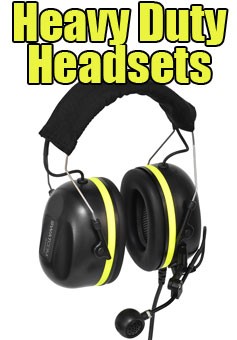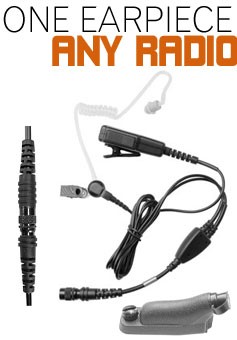
What is the earpiece?
An earpiece is a device worn either in or close to the ear, designed to allow for private and enhanced sound reception, offering a clearer audio experience than what is possible with conventional speakers. Earpieces have a vast range of applications, varying from personal use to professional settings.
Among the most common uses are radio earpieces, which serve as an extension of a two-way radio or walkie-talkie. This type of earpiece is indispensable in numerous environments—from nightclubs and bars to events and festivals—essentially anywhere that requires efficient, discrete communication over distances.
Additionally, earpieces are a staple tool for presenters, whether they are live on air or reporting from the field, allowing them to receive real-time instructions and updates. In more specialized contexts, earpieces are employed for close communication among members of the secret service, or by motorcyclists who integrate them into their helmets for seamless communication while on the road. The versatility and functionality of earpieces make them crucial in facilitating clear and covert communication across a broad spectrum of settings.
What is an example of an earpiece?
Earpieces can be described in various ways, depending on their specific use and design. For radio earpieces, the term often refers to the entire unit—encompassing the part that resides in or near the ear, the push-to-talk (PTT) button, and the connector that links to a radio or communication device. This comprehensive setup facilitates discreet and efficient communication, a must-have feature in environments where clear, immediate coordination is essential, such as security personnel at nightclubs or staff at large events.
On the other hand, when discussing hearing aids, an earpiece typically refers to the clear tube that delivers sound into the ear. This component is crucial for ensuring that users receive amplified sound that is as natural and clear as possible.
In day-to-day scenarios, especially on a night out, it's common to observe staff members equipped with earpieces. This not only underscores the widespread usage of these devices across various professions but also highlights their importance in maintaining seamless behind-the-scenes operations that contribute to the overall experience of patrons and guests.
Why do people wear earpieces?
People wear earpieces for a variety of critical reasons, primarily to control communication and ensure the messages passed through are precise and private. Radio earpieces, for instance, are connected to two-way radios, allowing users to communicate discreetly with each other and with others on the network. This discreet communication is invaluable in situations requiring coordination and privacy, such as in security operations or team management at large scale events.
In the context of television, presenters use earpieces to maintain a direct line of communication with their director and the control gallery, even while live on air. This enables them to receive real-time instructions, feedback, or updates, which is crucial for the dynamic environment of live broadcasting.
For individuals with hearing impairments, earpieces connected to hearing aids play a different yet equally vital role. They channel amplified sounds from the hearing aid directly into the user's ear, making it possible to hear more clearly in various environments. This not only enhances the user's ability to engage in conversations but also significantly improves their quality of life by making sounds more accessible.
How do you wear an earpiece?
Wearing an earpiece correctly is crucial for comfort and functionality, especially when your tasks demand constant communication. It's important to first identify whether you're using a one-wire or two-wire kit, as this will significantly affect how you wear it.
A one-wire kit is simpler, with a single wire connecting the radio to the push-to-talk (PTT) button and then extending to the earpiece itself. This setup typically requires you to run the wire along your body, making it less conspicuous and more streamlined, which is particularly useful in covert operations or when aiming for discretion.
On the other hand, a two-wire kit offers greater versatility. It starts from the connector, with one wire leading to the PTT button and microphone, and the second wire connecting to the earpiece. This arrangement allows for more wearing options, such as positioning the PTT button and microphone down your sleeve for easy access or discreetly attaching it to your lapel for swift communication. The second wire can then be run up your back and to your collar, keeping the earpiece secure and hidden. This flexibility makes the two-wire kit preferred in situations that require both discretion and accessibility.
Watch our video about how to put on an earpiece here -
Why do FBI agents wear earpieces?
FBI agents and members of the Secret Service wear earpieces as a critical tool for maintaining full, efficient, and effective communication while protecting an important asset. The use of earpieces allows these operatives to receive real-time updates, coordinate their movements, and quickly respond to any threats without drawing attention to their discussions.
This seamless flow of information is crucial in scenarios that require a high level of discretion and tactical coordination, ensuring that each member of the team is aware of their surroundings and any changes in the situation. Such communication capabilities are essential for the safety of the individuals they are entrusted to protect, as well as their own, enabling them to make informed decisions instantaneously.
Why do bouncers wear earpieces?
Bouncers or door supervisors employ earpieces as a key tool to facilitate seamless communication amongst themselves and with the management of the bar or club. This technology allows incidents to be relayed quickly and efficiently to anyone working, ensuring immediate response and coordination.
Whether it's handling unruly guests, managing crowd control, or responding to potential safety concerns, earpieces enable bouncers to discreetly exchange information without alarming patrons or interrupting the venue's atmosphere. This level of discreet communication is integral to maintaining a safe and enjoyable environment for all guests.
Why do celebrities wear earpieces?
Celebrities, particularly singers, wear in-ear monitors during performances for several crucial reasons. These devices allow them to hear their own voice clearly amidst the overwhelming noise of the crowd and the band. This personal mix of the music helps singers pitch correctly and maintain harmony with the music.
Furthermore, in-ear monitors can be used to block out the distracting noise of the audience, enabling artists to focus intently on their performance. They also serve as a channel for receiving instructions from directors or the production team discreetly. This real-time communication is essential for coordinating on-stage movements, adjusting performance pacing, or making spontaneous changes to the setlist.
In essence, in-ear monitors are vital for ensuring the quality and smooth execution of a live performance, making them an indispensable tool for modern entertainers.
Why do TV presenters wear earpieces?
TV presenters wear earpieces for seamless communication with the production team, allowing them to stay informed and agile during live broadcasts. These earpieces enable the presenter, whether in the studio or out in the field, to receive instructions from the gallery. This communication is crucial for understanding breaking stories, adhering to the running schedule, and even making last-minute changes to the script while on air.
This dynamic flow of information ensures that the presenter can smoothly segue between segments, introduce guests accurately, and address live developments, thereby maintaining the broadcast's professionalism and coherence.
Are headphones better than earpiece?
Headphones, particularly over-ear types, excel in providing superior passive noise isolation. This is largely because their design encompasses the entire ear, creating a seal that effectively blocks out external noise. On the other hand, earpieces are multi-dimensional, offering variations that include both in-ear and over-ear designs.
While in-ear earpieces can offer a degree of noise isolation by fitting directly into the ear canal, over-ear earpieces leverage their physical structure to isolate sound. This diversity in design allows earpieces to cater to a wide range of preferences and uses, from high-fidelity music listening to critical communication in professional settings.


























